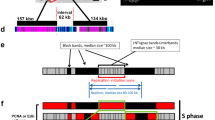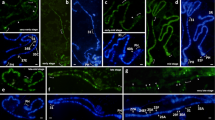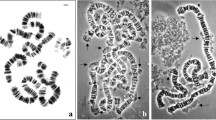Abstract
Using DNA fiber autoradiography, the rate of fork movement in D. virilis salivary glands was determined to be 0.1 μm/min (25 ° C). This value is 3.5 times slower than the replication rate determined in the diploid brain cells using the same experimental conditions (Steinemann, 1981). Replicon lengths in the polytene cells span from 5 to 203 μm, with a mean of ¯x= 46.7 μm and a median of \(\tilde x\)=39.5 μm. The polytene replicon length is about the same as that for diploid brain cells (31.0 μm). Dividing the haploid genome of D. virilis by the estimated number of 5,000 bands and taking the resulting 13.6 μm as average DNA length per chromomere, the average replicon length covers 3.4 chromomere units. This result does not support the concept that “one-band-plus interband” behaves as a replicating unit (Pelling, 1966). From the positive skew of the replicon length distributions, combined with the results derived from the chromosomal labelling patterns, the following schedule of chromosomal euchromatin doubling is infered: A short initiation period (discontinuous phase I), asynchronous with respect to individual origins, is followed by a phase of common replication activity at all inducible origins (continuous phase). The discontinuous II pattern is formed by few, long replicons which are still replicating while the shorter ones have already finished (weak points are not considered). Replicons, distributed in the main peak of the histogram and smaller than about 100 μm, are then responsible for the replication of the bulk of chromosomal euchromatin, the continuous phase. This interpretation is in conflict with the hypothesis assuming a clustered organization of the replicons to explain spot labelling (reviewed in Hand, 1978). The diploid karyotype of D. virilis contains 45% satellite sequences, located in the α-heterochromatin (Gall et al., 1971). They do not replicate in the highly polytene salivary gland cells of 3rd instar larvae. Comparison of DNA fiber autoradiograph patterns from salivary glands and brains suggests that these satellite sequences replicate in short (<10 μm), to some extent irregularly spaced replicons.
Similar content being viewed by others
References
Arcos-Terán, L.: DNS-Replikation und die Natur der spät replizierenden Orte im X-Chromosom von Drosophila melanogaster. Chromosoma (Berl.) 37, 233–296 (1972)
Atherton, D., Gall, J.G.: Salivary gland squashes for in situ nucleic acid hybridization studies. Dros. Inf. Serv. 49, 131–133 (1972)
Beermann, W.: Chromomeres and genes. In: Results and problems in cell differentiation. Vol. 4 (W. Beermann, J. Reinert, H. Ursprung, eds.), pp. 1–33. Berlin-Heidelberg-New York: Springer Verlag 1972
Callan, H.G.: Replication of DNA in the chromosomes of eukaryotes. Proc. roy. Soc. (Lond.) B 181, 19–41 (1972)
Dolfini, S., Courgeon, A.M., Tiepolo, L.: The cell cycle of an established line of Drosophila melanogaster cells in vitro. Experientia (Basel) 26, 1020–1021 (1970)
Edenberg, J.H., Huberman, J.A.: Eukaryotic chromosome replication. Ann. Rev. Genet. 9, 245–284 (1975)
Flamm, W.G., McCallum, M., Walker, P.M.B.: The isolation of complementary strands from a mouse DNA fraction. Proc. nat. Acad. Sci. (Wash.) 57, 1729–1734 (1967)
Gabrusewycz-Garcia, N.: Cytological and autoradiographic studies in Sciara coprophila salivary gland chromosomes. Chromosoma (Berl.) 15, 312–344 (1964)
Gall, J.G., Cohen, E.H., Polan, M.L.: Repetitive DNA sequences in Drosophila. Chromosoma (Berl.) 33, 319–344 (1971)
Hägele, K.: DNS-Replikationsmuster der Speicheldrüsen-Chromosomen von Chironomiden. Chromosoma (Berl.) 31, 91–138 (1970)
Hägele, K.: Komplementäre DNA-Replikationsmuster bei Drosophila melanogaster. Chromosoma (Berl.) 41, 231–236 (1973)
Hand, R.: Eucaryotic DNA: Organization of the genome for replication. Cell 15, 317–325 (1978)
Keyl, H.-G., Pelling, C.: Differentielle DNS Replikation in den Speicheldrüsen-Chromosomen von Chironomus thummi. Chromosoma (Berl.) 14, 347–359 (1963)
Lima-De-Faria, A.: Initiation of DNA synthesis at specific segments in the meiotic chromosomes of Melanoplus. Hereditas (Lund) 47, 674–694 (1961)
Pelling, C.: A replicative and synthetic chromosomal unit — the modern concept of the chromomere. Proc. Roy. Soc (Lond.) B 164, 279–289 (1966)
Plaut, W.: On the replicative organization of DNA in the polytene chromosome of Drosophila melanogaster. J. molec. Biol. 7, 632–635 (1963)
Plaut, W., Nash, D., Fanning, T.: Ordered replication of DNA in polytene chromosomes of Drosophila melanogaster. J. molec. Biol. 16, 85–93 (1966)
Rabinowitz, M.: Studies on the cytology and early embryology of the egg of Drosophila melanogaster. J. Morph. 69, 1–49 (1941a)
Rudkin, G.T.: Replication in polytene chromosomes. In: Results and problems in cell differentiation. Vol. 4 (W. Beermann, J. Reinert and H. Ursprung, eds.), pp. 59–85. Berlin-Heidelberg-New York: Springer Verlag 1972
Schildkraut, C.L., Marmur, J., Doty, P.: Determination of the base composition of deoxyribonucleic acid from its buoyant density in CsCl. J. molec. Biol. 4, 430–443 (1962)
Steinemann, M.: The in situ formation of DNA·DNA duplexes of Drosophila virilis satellite DNA. Chromosoma (Berl.) 54, 339–348 (1976)
Steinemann, M.: Co-replication of satellite DNA of Chironomus melanotus with mainband DNA during polytenization. Chromosoma (Berl.) 66, 127–139 (1978)
Steinemann, M.: Chromosomal replication in Drosophila virilis. I. Diploid karyotype of brain cells. Chromosoma (Berl.) 78, 211–223 (1980)
Steinemann, M.: Chromosomal replication in Drosophila virilis. II. Organization of active origins in diploid brain cells. Chromosoma (Berl.) 82, 267–288 (1981)
Stubblefield, E.: Analysis of the replication pattern of chinese hamster chromosomes using 5-bromodeoxyuridin suppression of 33 258 Hoechst fluorescence. Chromosoma (Berl.) 53, 209–221 (1975)
Stubblefield, E., Mueller, G.C.: Molecular events in the reproduction of animal cells. II. The focalized synthesis of DNA in the chromosomes of Hela cells. Cancer Res. 22, 1091–1099 (1962)
Vinograd, J., Morris, J., Davidson, N., Dove, W.F., Jr.: The buoyant behavior of viral and bacterial DNA in alkaline CsCl. Proc. nat. Acad. Sci. (Wash.) 49, 12–17 (1963)
Zakian, V.A.: Electron microscopic analysis of DNA replication in main band and satellite DNAs of Drosophila virilis. J. molec. Biol. 108, 305–331 (1976)
Author information
Authors and Affiliations
Additional information
Presented to Professor Dr. Wolfgang Beermann on the occasion of his 60th birthday with my best wishes
Rights and permissions
About this article
Cite this article
Steinemann, M. Chromosomal replication in Drosophila virilis . Chromosoma 82, 289–307 (1981). https://doi.org/10.1007/BF00286112
Received:
Issue Date:
DOI: https://doi.org/10.1007/BF00286112




